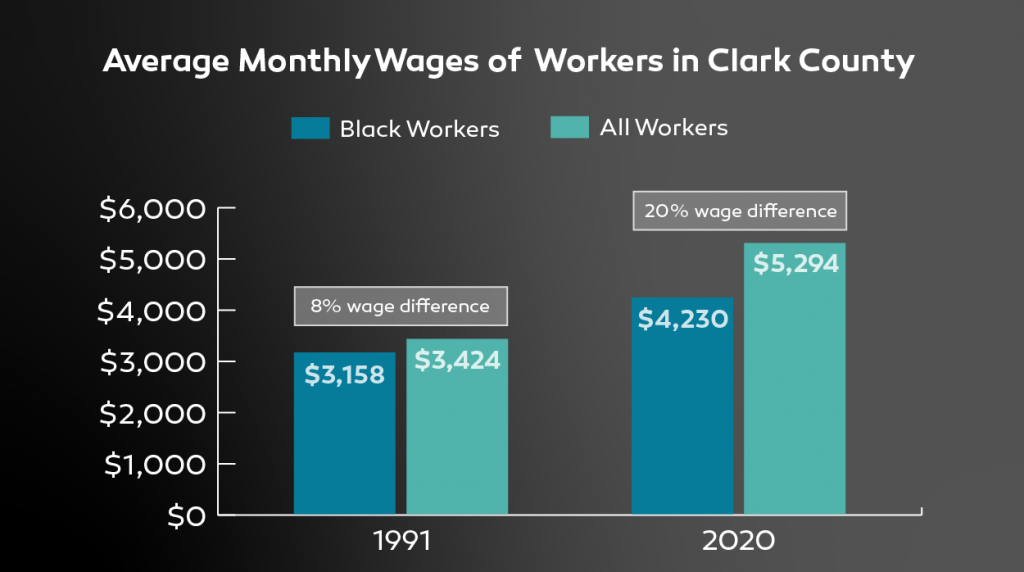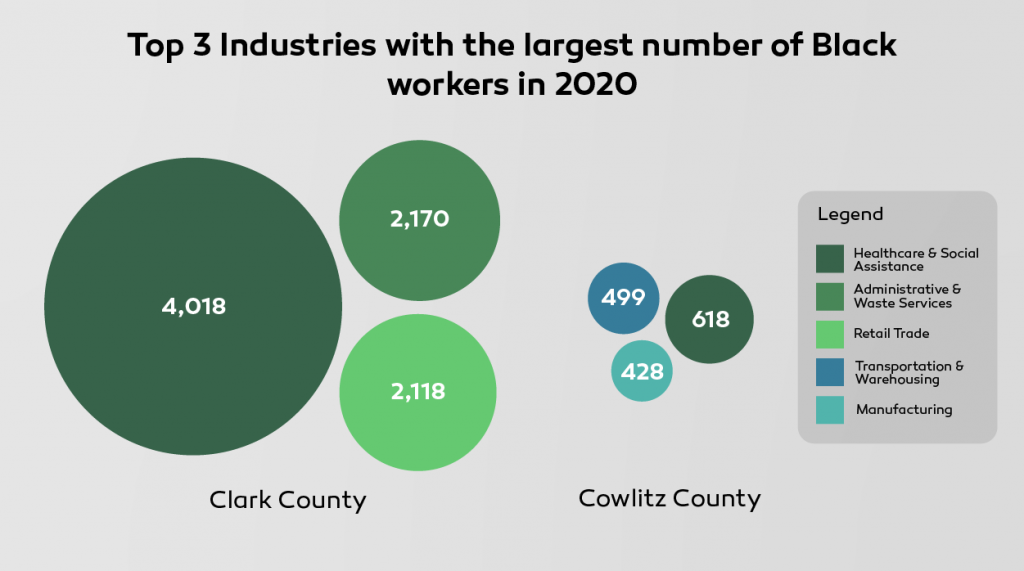Nationally, Black workers and other people of color face wage and employment disparities. Southwest Washington’s workforce reflects these national trends, with Black workers falling behind in average earnings. In addition, the COVID-19 pandemic disproportionately affected Black Americans in the workforce.
According to McKinsey, there is a $220 billion annual wage disparity between Black wages today and what they would be in a scenario of full parity. In the United States, Black workers comprise 12.9% of the labor force but earn only 9.6% of total wages.
“The median wage for all U.S. workers is around $42,000 per year, but 43 percent of Black workers earn less than $30,000 per year.” – The economic state of Black America: What is and what could be, McKinsey & Company
 In Clark County, wage disparities for Black workers mirror the national course. In 1991, the average monthly wage for non-federal Black workers in Clark County was $3,158 – about 8% lower than the average for all workers of $3,424. In 2020, the average wage for Black workers was $4,230 – about 20% lower than the average for all workers of $5,294. These number reflect the growing disparities between Black workers and the overall workforce.
In Clark County, wage disparities for Black workers mirror the national course. In 1991, the average monthly wage for non-federal Black workers in Clark County was $3,158 – about 8% lower than the average for all workers of $3,424. In 2020, the average wage for Black workers was $4,230 – about 20% lower than the average for all workers of $5,294. These number reflect the growing disparities between Black workers and the overall workforce.
In addition to wage disparities, Black workers tend to be underrepresented in high-wage occupations and tend to get fewer advancement opportunities. According to McKinsey, almost half of Black workers work in healthcare, retail, and accommodation and food service. Within these industry, Black workers are disproportionately represented in lower-paying roles, instead of managerial or professional positions.
In Clark County, the three industries with the most Black workers are Healthcare and Social Assistance, Administration and Waste Services, and Retail Trade. Those in stable jobs in these industries in Southwest Washington during Q2 of 2019-Q2 of 2020 on average made $44,588, $34,774 and $34,913 in 2020 respectively.

In Cowlitz County, the three industries with the largest numbers of Black workers are Healthcare and Social Assistance, Transportation and Warehousing, and Manufacturing. Those in stable jobs in these industries in Southwest Washington during Q2 of 2019-Q2 of 2020 on average made $44,588 in Healthcare and Social Assistance and $59,789 in Manufacturing. Wage data on Transportation and Warehousing is not available. This compares to the $52,849 yearly average wage in Southwest Washington during the same period.
The growing wage gap for Black workers and other people of color is one of the disparities WSW’s Strategic Plan seeks to address. Our Strategic Plan focuses on Business Growth, Economic Mobility and Systems Change. During 2021 and 2022, WSW conducted an analysis of race and ethnicity data across the workforce system, implemented diversity, equity and inclusion (DEI) trainings for the staff at the adult and youth career and employment centers, expanded targeted outreach efforts, continued work on the Quality Jobs Initiative with the aim of supporting high-quality employment for all, and more!
By identifying equitable ways to invest workforce dollars and citing specific goals in our contracts with service providers to include outreach to and engagement with historically-underserved communities, our goal is to increase access to and enrollments in public workforce development services. Learn more about what WSW is doing at Our Plan webpage.
For businesses seeking to provide training and advancement opportunities for a diverse workforce, WSW currently has applications open for Employee Training Grants. Learn more about the program and how to apply.



